10 Best Native Plants for Cleveland, OH
BY ABDUL WADOOD | APRIL 5TH, 2023 | CLEVELAND, LAWN CARE, OHIOCleveland is called the Forest City for a reason. It’s home to many gardens, including the world-famous Cleveland Cultural Gardens. You can have a fantastic garden, too, especially if you choose easy-to-maintain native plants that thrive in Ohio’s diverse climate.
Here is a look at 10 of the best native plants for Cleveland.
In this article:
- Why Choose Native Plants?
- Best Native Plants for Your Cleveland Lawn
- How To Choose the Best Native Plants for Your Cleveland Lawn?
- Where To Find Native Plants in Cleveland?
Why Choose Native Plants?
Native plants, as the name suggests, belong to a local region. They are well-adapted to a region’s climate and soil conditions as they have been growing there for several years.
Here’s why native plants are better than non-natives.
- They require less maintenance as they grow in the area naturally.
- They attract pollinators such as native bees, moths, butterflies, and hummingbirds.
- They need fewer chemical treatments.
- They require less water as they naturally thrive in local environmental conditions.
Best Native Plants for Your Cleveland Lawn
1. Bee Balm (Monarda Didyma)
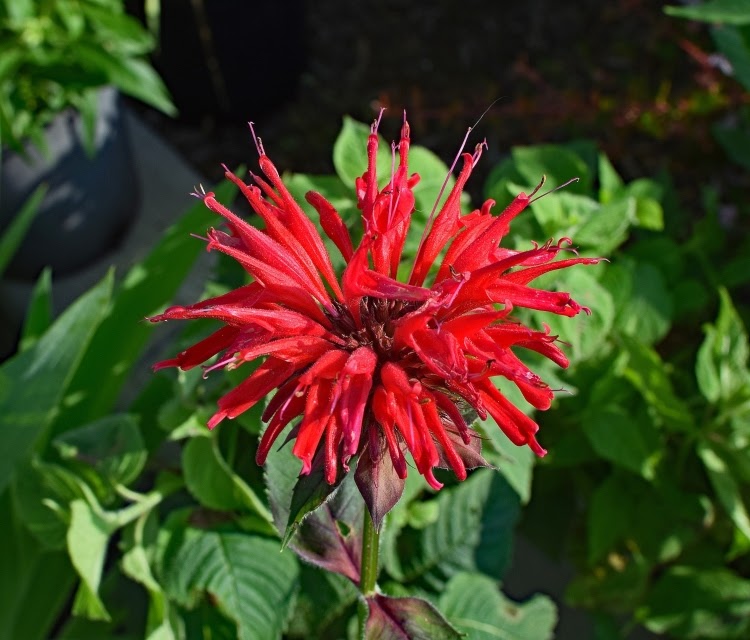
Photo Credit: Pixabay
Bee balm looks beautiful with its bright scarlet flowers. The foliage has a minty fragrance as they are part of the mint family. Bee balm performs best in full sun and moist soil.
Bee balm blooms throughout the summer, and the flowers attract bees and butterflies. Songbirds like to snack on their seed heads during fall and winter.
Growth habit: Flower
Mature size: Up to 4 feet tall and 3 feet wide
Duration: Perennial
Foliage: Dark green
Sunlight needs: Full sun
Soil preferences: Rich, moist soil
Water needs: High
Potential hazards: Non-toxic
2. Wild Geranium (Geranium Maculatum)
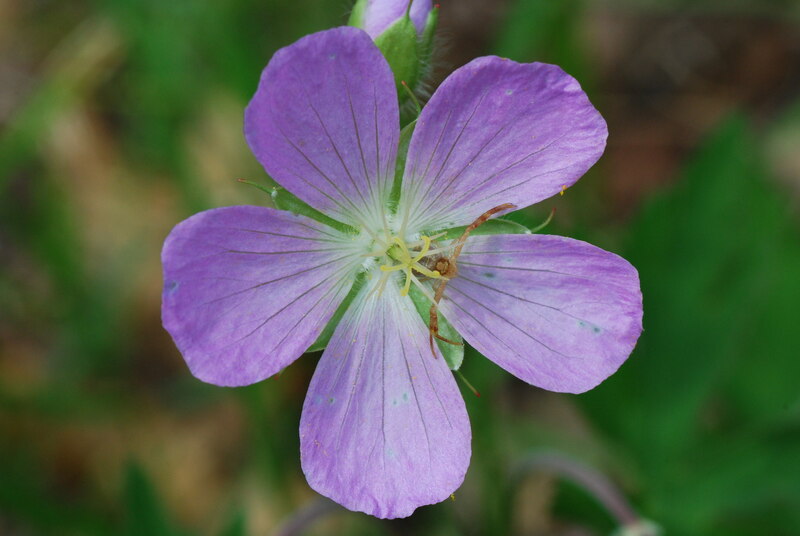
Photo Credit: Joshua Mayer / Flickr / CC BY-SA 2.0
Wild geranium features palmate-shaped leaves with five petals. The flowers come in pink or lavender colors. Wild geraniums are beautiful and attract bees, butterflies, and other pollinators.
Wild geraniums bloom for a lengthy period, from late spring to early summer. They prefer moist soil and grow well in full or partial sun.
Growth habit: Flower
Mature size: Up to 3 feet tall and 2 feet wide
Duration: Perennial
Foliage: Green
Sunlight needs: Full sun or partial shade
Soil preferences: Rich, moist soil
Water needs: Needs high watering during the growth period. Once matured, it requires watering only in drought conditions.
Potential hazards: Non-toxic to children. Toxic to pets.
3. Black-Eyed Susan (Rudbeckia Hirta)
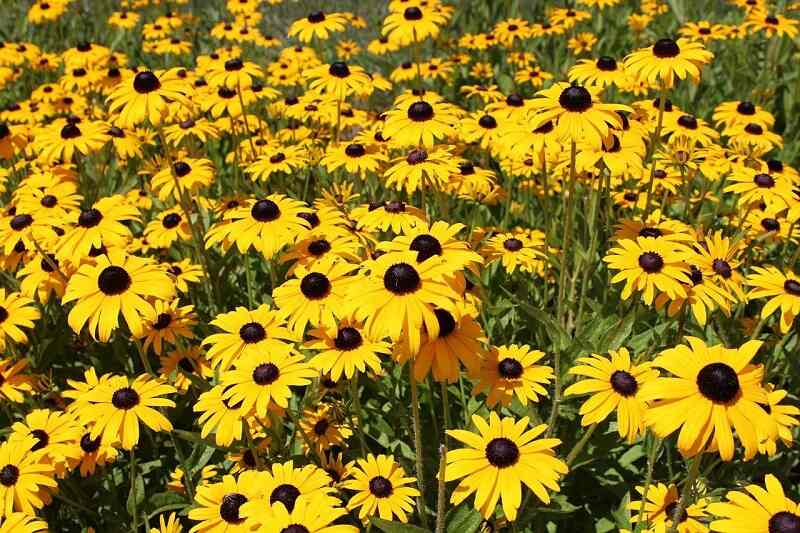
Photo Credit: Pixabay
Black-eyed Susan blooms throughout the summer, adorning your lawn with bright-yellow flowers with dark brown beads in the center. They are fast-growing climbers that attract birds, butterflies, and other pollinators.
Black-eyed Susan requires low maintenance and grows best in full sun and well-drained soil. You can remove the dead heads of the faded flowers to keep black-eyed Susan in bloom for much longer.
Growth habit: Flower
Mature size: Up to 5 feet tall and 3 feet wide
Duration: Perennial
Foliage: Deep green
Sunlight needs: Full sun
Soil preferences: Moist, well-drained
Water needs: Low, high drought tolerance
Potential hazards: Non-toxic
4. Cardinal Flower (Lobelia Cardinalis)

Photo Credit: rockerBOO / Flickr / CC BY-SA 2.0
Cardinal flowers look attractive with their two-lipped bright red tubular flowers. They bloom during hot summers when most plants are done blooming. Cardinal flowers require low maintenance and can tolerate partial shade but not drought.
Cardinal flowers depend on hummingbirds for fertilization as other insects can’t make their way in to reach the nectar because of the flower’s shape.
Growth habit: Flower
Mature size: Up to 4 feet tall and 2 feet wide
Duration: Perennial
Foliage: Dark green
Sunlight needs: Full sun to partial shade
Soil preferences: Moist,well-drained soil
Water needs: High
Potential hazards: Toxic to humans and pets
5. Butterfly Weed (Asclepias Tuberosa)
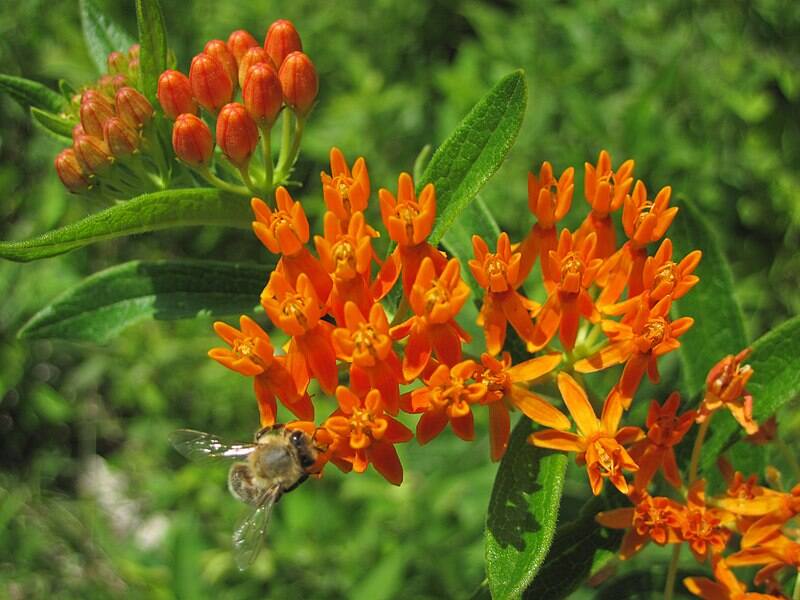
Photo Credit: James St. John / Wikimedia Commons / CC BY 2.0
Butterfly weed features clusters of bright orange flowers that attract bees, hummingbirds, and especially monarch butterflies. They require little maintenance and can tolerate drought conditions.
Butterfly weed blooms from late spring and stays the same throughout the summer. During fall, the leaves of butterfly weed turns dull yellow, and the flowers burst open to reveal their fluffy white seeds.
Growth habit: Flower
Mature size: Up to 2 feet tall and 2 feet wide
Duration: Perennial
Foliage: Dark green
Sunlight needs: Full sun
Soil preferences: Dry, well-drained soil
Water needs: Low, high drought tolerance
Potential hazards: Toxic to humans and pets
6. White Wood Aster (Eurybia Divaricata)
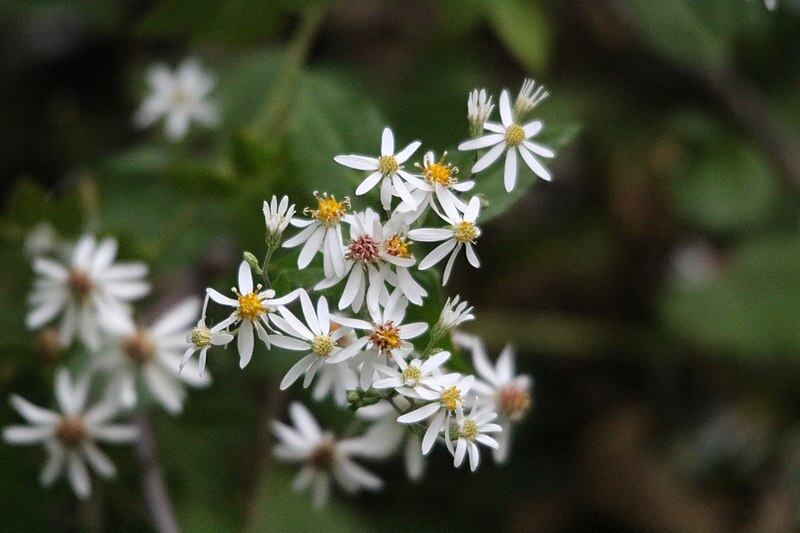
Photo Credit: Mets501 / Wikimedia Commons / CC BY-SA 4.0
White wood aster looks beautiful and blends well with other plants on your lawn. They bloom in late summer, producing small white flowers with yellow centers that gradually turn red. Butterflies love white wood asters.
White wood aster tolerates drought and can grow in rocky soil. These plants only require three hours of partial sunlight a day.
Growth habit: Flower
Mature size: Up to 3 feet tall and 4 feet wide
Duration: Perennial
Foliage: Dark green
Sunlight needs: Partial sun. Can tolerate full shade.
Soil preferences: Moist, well-drained soil. Can survive in rocky soil.
Water needs: Low, high drought tolerance
Potential hazards: Non-toxic
7. Perennial Coneflower (Echinacea Purpurea)
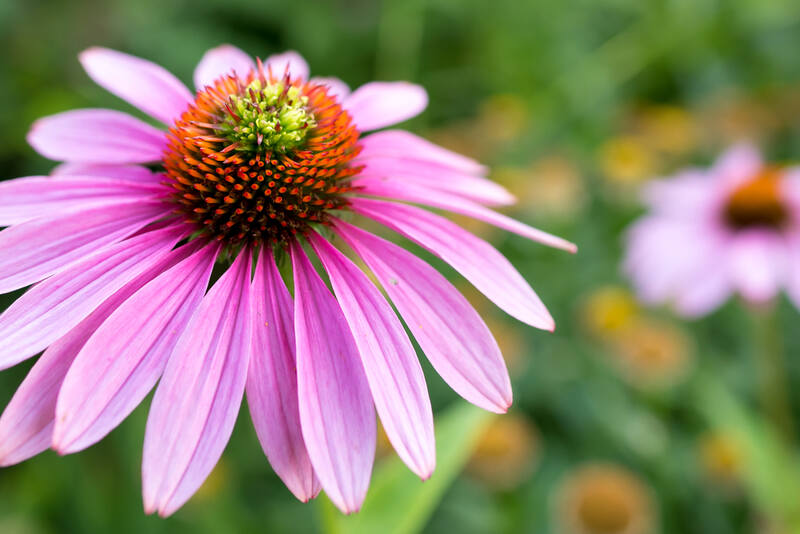
Photo Credit: Pxhere
Perennial coneflower looks distinctive with reddish-purple petals. It blooms from early summer through early fall. Perennial coneflower attracts birds and butterflies when in full bloom.
This plant grows in rocky soils, making it a great option for low-maintenance lawns. It tolerates drought but doesn’t tolerate shade very well.
Growth habit: Flower
Mature size: Up to 4 feet tall and about 1.5 feet wide
Duration: Perennial
Foliage: Dark green
Sunlight needs: Full sun
Soil preferences: Moist, well-drained soil. Can survive in rocky soil.
Water needs: Moderate
Potential hazards: Non-toxic
8. Obedient Plant (Physostegia Virginiana)
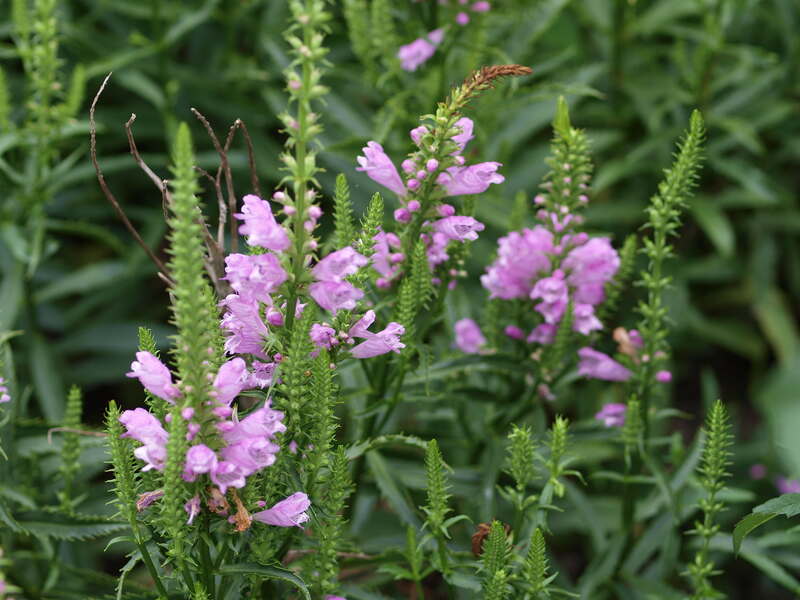
Photo Credit: F. D. Richards / Flickr / CC BY-SA 2.0
The obedient plant, also known as false dragonhead, blooms from late summer to fall. The flowers appear in light shades of pink and white. They attract bees, butterflies, and other pollinators when in full bloom.
Obedient plant is easy to grow and requires little maintenance. Wondering how obedient plant got its name? These plants hold their position when bent.
Growth habit: Flower
Mature size: Up to 4 feet tall and 3 feet wide
Duration: Perennial
Foliage: Green
Sunlight needs: Full sun
Soil preferences: Moist, well-drained soil
Water needs: High
Potential hazards: Non-toxic
9. Wood Poppy (Stylophorum Diphyllum)
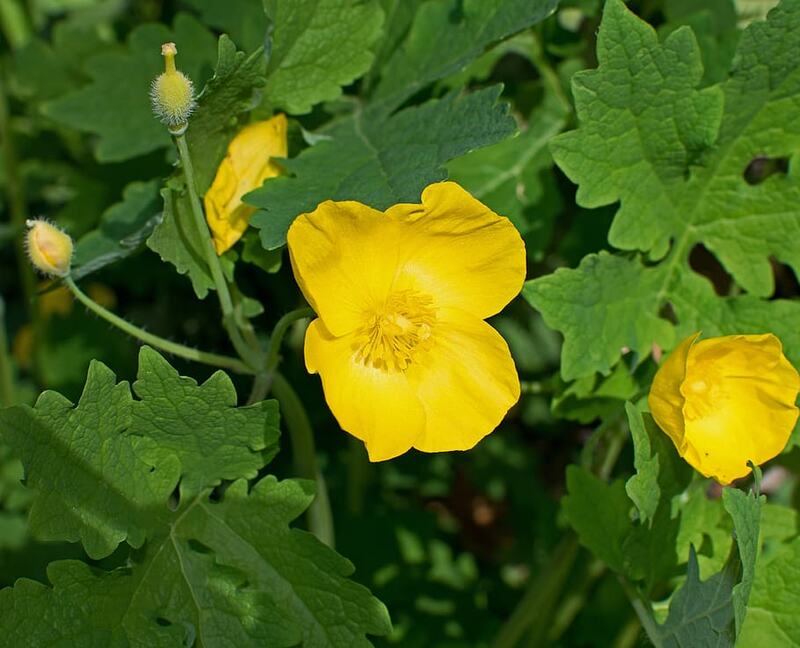
Photo Credit: Pxfuel
Wood poppies look attractive with their bright yellow flowers. They can grow under full shade, making them a great option for shady lawns. They can resist diseases and perform best in well-drained soil.
Wood poppies bloom from spring to early summer. Remove the dead heads of the old flowers to make the plant bloom much longer.
If you like chipmunks, wood poppies are a must-have on your lawn. These cute creatures love the seeds produced by this plant.
Growth habit: Flower
Mature size: Up to a foot tall and a foot wide
Duration: Perennial
Foliage: Bluish green
Sunlight needs: Partial to full shade
Soil preferences: Moist, well-drained soil
Water needs: High
Potential hazards: Toxic to humans and pets
10. Savanna Blazing Star (Liatris Scariosa)
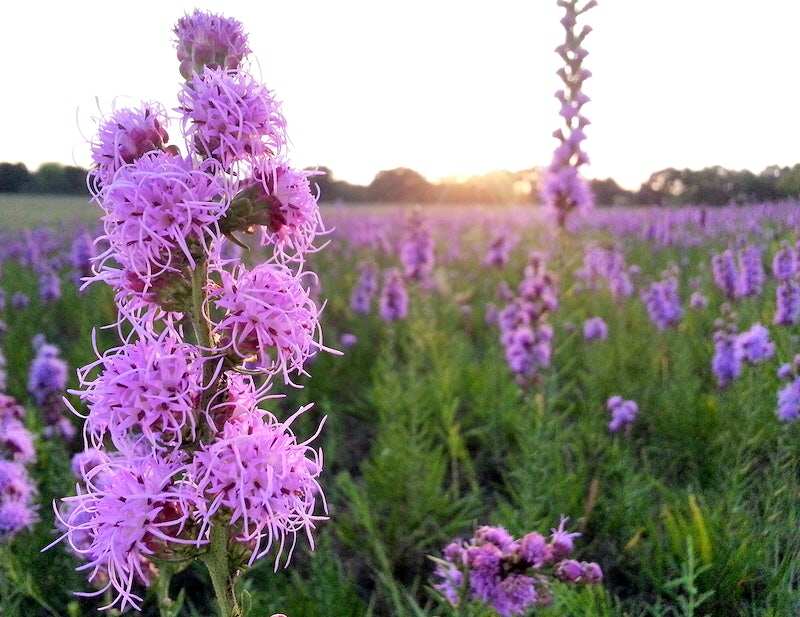
Photo Credit: Rawpixel
Savanna blazing star is rare to spot in Cleveland, but it’s native to Ohio and can adapt to the climate of the Forest City. It looks appealing with its bright pink shaggy flower heads. Savanna blazing star grows best in full sun and can tolerate drought and rocky soil.
Savanna blazing star blooms from late summer to mid-fall and lasts about 1.5 months. They attract butterflies and hummingbirds when in full bloom.
Growth habit: Flower
Mature size: Up to 5 feet tall and 2 feet wide
Duration: Perennial
Foliage: Medium green
Sunlight needs: Full sun to partial shade
Soil preferences: Moist, well-drained soil
Water needs: High
Potential hazards: Non-toxic
How To Choose the Best Native Plants for Your Cleveland Lawn?
Cleveland’s hardiness zone is 6, meaning the winters are cold and summers are warm. The plants listed here are native to Cleveland and survive nicely in the area’s climate. Select a plant that best suits your lawn’s conditions and satisfies your requirements.
If you have children and pets playing on your lawn, we suggest you choose non-toxic plants. Make sure to consider a plant’s growing size when you purchase it. Some plants grow too big, which may not suit your yard.
Where To Find Native Plants in Cleveland?
Here are Cleveland nurseries that sell native plants.
- Urban Planting Cleveland
- Lakewood Plant Company
- Recreational Pots and Plants
- Gale’s Westlake Garden Center
Sometimes, native plants may be already growing on your lawn. So, don’t forget to look around your yard for these plants.
Native plants can increase the appeal of your yard. But your lawn won’t be complete without planting the best grass types in Cleveland. A lush, green, and healthy lawn is a combination of everything, including proper maintenance.
If you want someone to help you to maintain your lawn, consider hiring Wikilawn Cleveland lawn care experts.
Main Image Credit: USFWS Mountain-Prairie / Flickr / CC BY 2.0